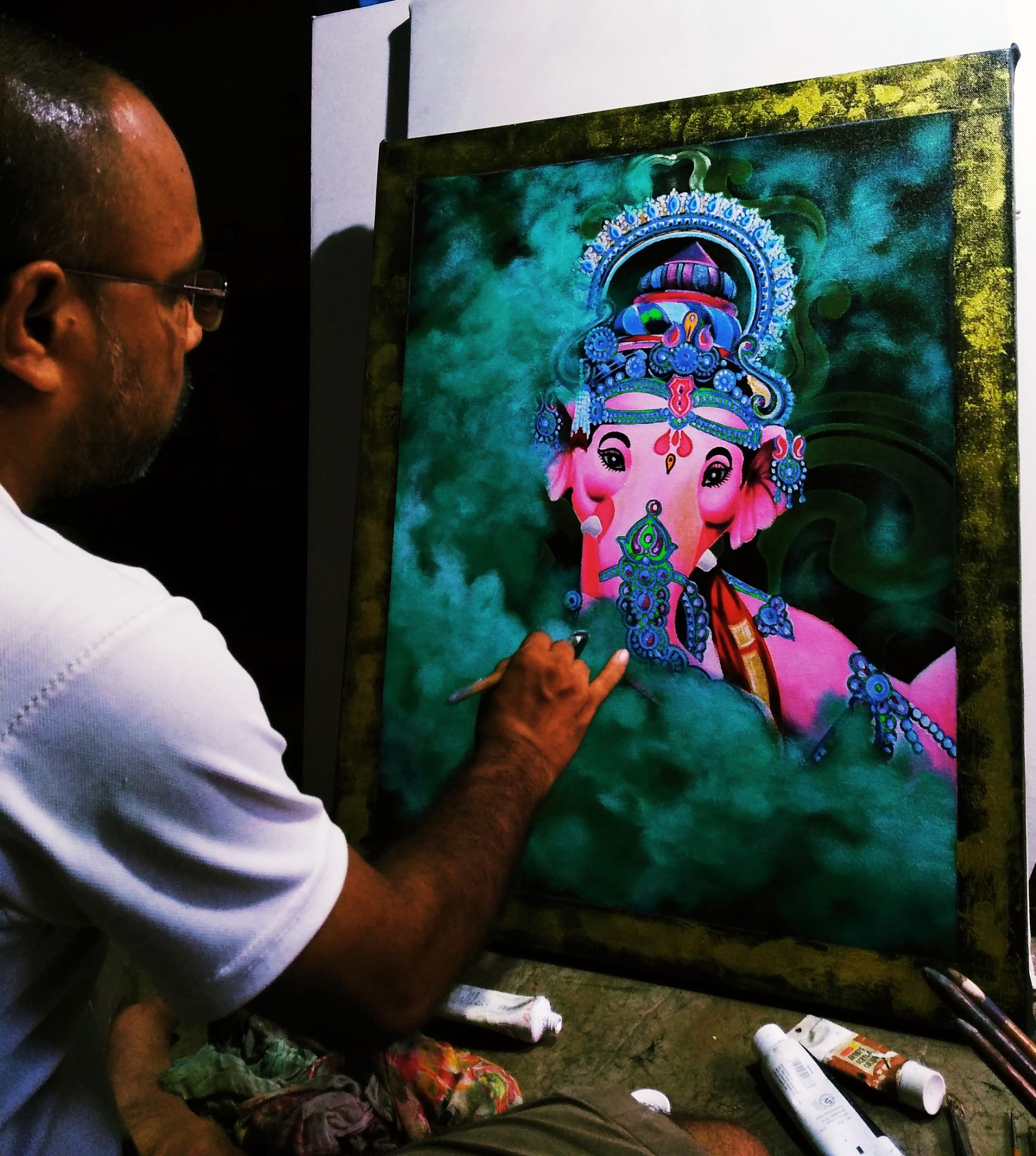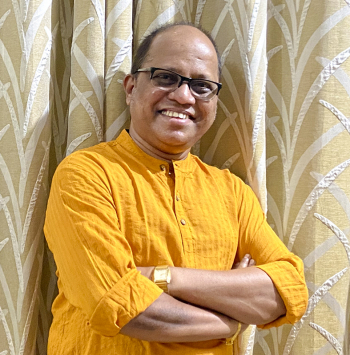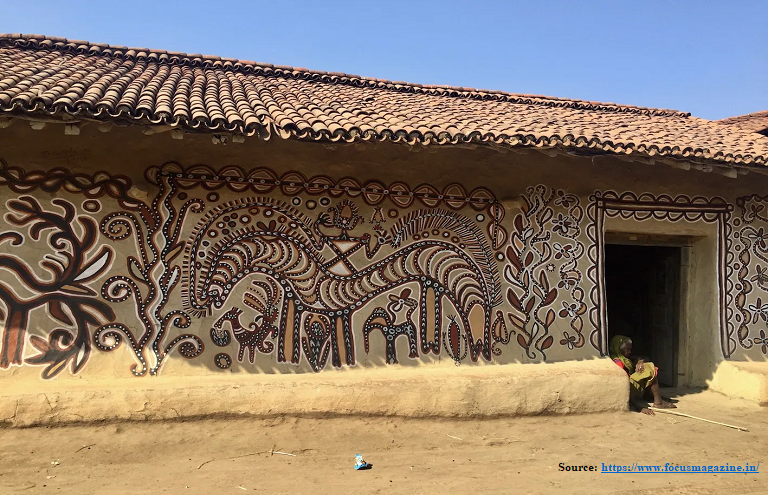
Diverse in technique, pattern, and design, folk art in the form of mud murals have been an integral part of the domestic architecture of Jharkhand in eastern India for ages!
Mud has been used as a building material since ancient times and still continues to be the primary material for the construction of rural dwellings in many parts of rural Jharkhand. The regular maintenance including annual repair and plastering of these mud houses becomes an occasion for creating intricate designs and elaborate patterns in the form of murals among different communities of the region such as Santals, Oraons, Kurmis, Agarias, Bhuiyans, Ghatwals, and Ganjus.
Explore some famous mural designs painted in the various regions of Jharkhand here:
-
Khovar & Sohrai
Popular in the Hazaribagh region of Jharkhand, this folk art draws heavily from forest life with sparrows, peacocks, squirrels, and cows primarily inhabiting the world of these wall paintings.
One category of paintings practiced in the region is known as Khovar (‘kho’ meaning room and ‘var’ meaning bridal couple) and refers to the decoration of the bridal room or marriage chambers. The other type of mural art done is Sohrai which is believed to bring good luck. Also known as harvest painting, it is made on the occasion of the annual harvest on the mud houses, repairing it after the rains and offering thanksgiving to the Mother Nature. Depending on the community, the designs of these murals vary, with some depicting the mythical tree of life, or flowers, plants, animals such as elephant, and other ritually significant forms such as Pashupati (the lord of animals).
Though motifs vary across communities and villages, the basic technique of painting these mud mural is broadly the same. Firstly, the surface of the mud wall is covered in the dark manganese-rich clay or kali mitti, which also provides wall some protection against the weather. Secondly, the surface is covered with light brown or white kaolin clay (Dudhi mitti). Occasionally, the kaolin clay is applied in a square block with patterns of straight or curved lines made by the fingers, carrying ritual significances and symbolizing the house itself. Once this wall surface is prepared, motifs are painted in red, ochre, and black color.
In the case of elaborate designs such as the Kurmi mural art, the designs are first drawn on the wall using a sharp object such as a nail. Later on, the designs are painted using a brush made of the chewed tooth-sticks (datwan) or twig of the neem tree or a piece of cloth dipped in color if the motifs are quite large in size.
-
Khovar Using Stencil Technique
Women artists of the Ghatwal, Agaria, and some Kurmi communities in Hazaribagh, paint murals on the mud walls using a stencil-type method, often described as glyptic. This involves the segmentation of the wall into large rectangular panels while applying the layer of kaolin clay. Then, using a darker red or black clay, the negative spaces within the panel are painted, leaving some areas in white that form the animal or plant motif. This is quite a complicated technique as it requires the artist to visualize and paint not the motif but the space surrounding the main mural design.
-
Horizontal Colorful Bands
This is the basic mural design practiced in the Singhbhum region of south Jharkhand. Communities such as Mundas or Mahatos use two or three different shades of colors, wherein usually black is used at the base of the wall while red and white are applied towards the top of the mud wall. However, the houses of the Santal community are more brightly colored.
Firstly, the clay is applied and once the wall surface is ready, lines are drawn to demarcate clearly the bands of color using lengths of string that are held tightly against the wall surface using nails. Next, lines are traced along the stretched string. Meanwhile, the colored clays are mixed with water in preparation for painting the bands created. Using a piece of cloth dipped into the color, horizontal strokes are applied on the wall using to fill in the bands. Usually, the artist starts by painting the top of the wall and then move down towards the base, working in vertical blocks until the entire wall is painted. Also, great care and expertise are required to produce an evenly painted surface with clean and precise edges between two colors. Occasionally, artists also add some details such as a line of flowers or small decorative motifs in the bands created in some places such as the front door of the house.
-
Geometric patterns
Compared to the other types of mural design practiced in Hazaribagh, this wall art is distinctive for its sharp geometry.
Painted by the Santal women in the Hazaribagh region, this design scheme involves lengths of geometric patterns with a slightly more restricted color palette unlike the designs of Singhbhum. For example, Santal murals often have zigzag lines in red and black color added along the length of the mud wall. These are usually painted using a piece of cloth, but here too the artists pay more attention to achieving precise edges in order to produce neat and smooth murals.
-
Motifs Within Horizontal Band
Practiced in some Santal villages in the Seraikela region, this design comprises of elaborate shapes or detailed and intricate motifs within the horizontal bands of the mural painted. The main difference between such murals and the simple horizontal bands is of the painting tool. This design involves the use of the paintbrush for painting the finer details, whereas painting with a cloth only produces large swathes of color. Usually, women paint complex geometric compositions such as basic shapes starkly juxtaposed onto one another or add natural motifs such as flowers, minute floral designs, and insects.
Due to the addition of intricate motifs and shapes, these murals typically require more effort and time to complete. Hence, women often hire labor to assist them in their everyday domestic chores so as to find extra time to finish off these mud murals.
-
Sculpted Surfaces
Practiced in very few villages of Singhbhum, this is one of the more unusual designs and involves the carving of mud columns of the house and then painting them in vibrant bright colors.
This is a complex technique and involves the making of a column by stacking layers of mud which is, later on, carved out it into desired shapes after the mud has set. The column is then plastered following the regular process of applying clay. However, these are not considered strictly murals, but the process is clearly part of the gamut of decorative practices for mud houses.
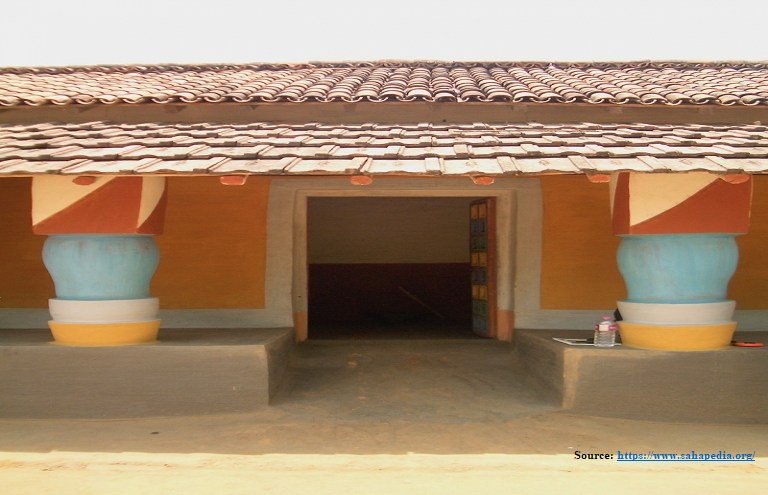
-
Comb-Cut Art
Comb-cutting of clay is carried out by Kurmi women in some villages around Hazaribagh.
Firstly, a layer of black manganese clay is applied to the mud wall, and then the second layer of whitish kaolin clay is applied. When the second layer is just set (but not fully dry), using broken combs or their fingers, the women artists scrape out the lighter earth creating lyrical, black, and white silhouettes with exaggerated brushstrokes. Elephants, big cats, deer, peacock, and floral designs are common motifs created in this manner. The final mural is a subtle work in the muted earthy colors of the natural clays used.
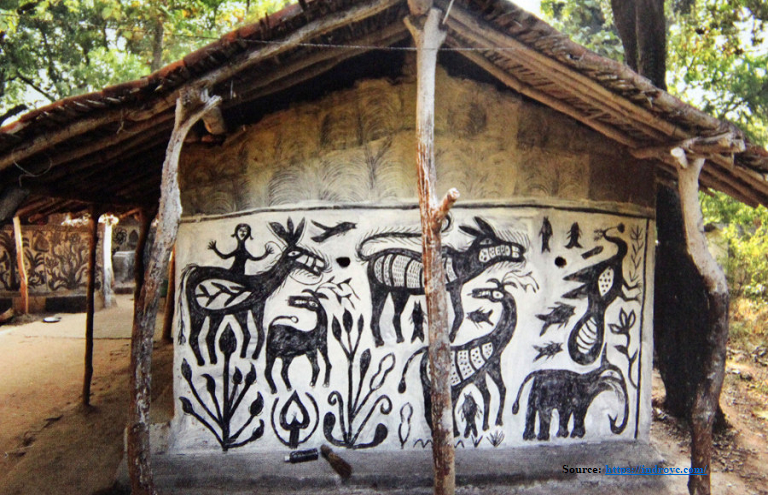
-
Painting A New Story
In recent years, these ritualistic art forms seem to be vanishing in the villages since mud walls are being replaced by brick and cement plaster. Also, there has been increased migration from the villages and the young girls are reluctant to undertake the strenuous work of painting murals along with their studies.
However, owing to the efforts of the environment activist Bulu Imam, who first discovered the rock art near Hazaribagh in 1991, these art forms have received a lot of attention across the country. Today, murals are making their way from the mud walls to the pages in the course of their journey to revival and transformation.
In 2009, the art form made its presence felt strongly when the famous terracotta artisan from Bundu (Ranchi), Reshma painted the over-bridge at Katru with Sohrai motifs. Also, the same year around 20 tribal women artists from Hazaribagh painted the outer walls of Birsa Munda Zoological Garden with the beautiful murals inspired by Khovar and Sohrai art forms.
With the rise in the mud mural’s popularity, the state art and culture department of Jharkhand plans to paint the walls of various government buildings, railway stations, and airports with colorful murals of tribal Khovar and Sohrai designs. Also, various railway stations in the towns like Hazaribagh and Jamshedpur now greet travelers with Khovar and Sohrai murals that only adorned village homes in Jharkhand until recently.











